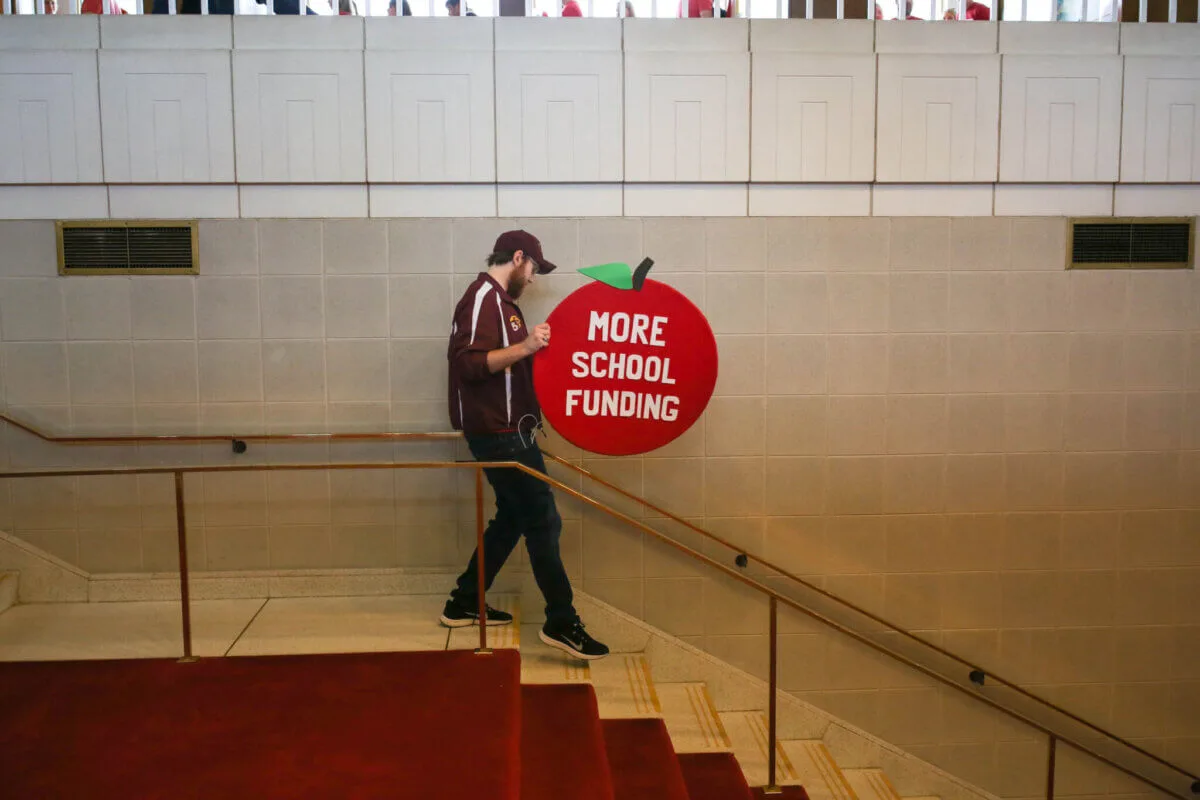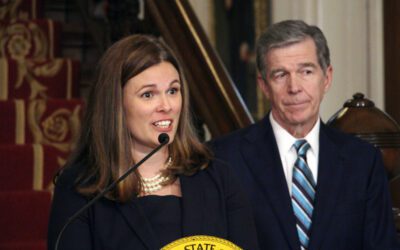
LOGAN CYRUS/AFP via Getty Images
Schools across the state are dealing with dilapidated classrooms and buildings in need of significant repair or a total rebuild due to a lack of investment in public education.
As the long, sticky summer days of 2023 wound down in late August, most North Carolina public school students returned to classes, marking the start of a brand new academic year.
Families in Alamance County, however, were greeted with far less welcome news, when an excessive amount of mold was found at multiple Alamance-Burlington Schools (ABSS), leading the school district to delay classes by two weeks.
We cover NC education. Sign up for our free, award-winning newsletter.
After further investigation, district officials determined that 30 schools had some levels of mold that needed to be dealt with, including 16 that had excessive mold called Chaetomium, which “is highly dangerous and triggers infections in humans.”
Alamance County parent Tameka Harvey was among those impacted by the delays.
“I have two children and a nephew who attend Cummings High School,” Harvey told Cardinal & Pine.
Cummings was one of the schools where toxic mold was found, presenting serious health risks to students. Harvey says that while the issues at Cummings made news this year, they’ve existed for years, dating back to at least 2017, when former school board member Patsy Simpson visited the school and was informed about the mold growth.
“Instead of taking care of the issue, they put a band-aid over it. Which is what happens a lot in Alamance County. They actually painted over some mold and took a few tiles out,” she said, noting that the effort removed the visibility of the mold, but not the mold itself.
“That mold was still there,” Harvey said.
In response to the mold crisis in August, Alamance County spent $17 million to rid schools of mold and to make the air in the impacted schools–including Cummings–safe to breathe. The district created a dashboard where the public can see that all schools have been cleared. The dashboard also lists how many air quality tests were conducted, and what the process to clear a school looks like.
But Harvey still has some concerns about the air quality and safety of the schools.
“Still to this day, we do not have certified air quality results for the schools, which was promised to us,” she said.
At the September 25th Board of Education Meeting, she says she asked specifically about the air quality results for the schools. At this point, the schools had been open for a few weeks, and Harvey says ABSS informed the community that it would take 7-14 days for that information to be made available. However, it has now been over two months since the schools opened back up, and Harvey is still waiting for the data.
The mold issue is just one example of the district’s infrastructure issues. According to the 2020-2021 Facility Needs Survey prepared by the North Carolina Department of Public Instruction (DPI), ABSS schools stated that the district needed $257 million dollars to meet the county’s needs, which included school repairs, the building of new schools, and to furnish classrooms, among other things.
Cardinal & Pine reached out to ABSS Board of Education Members Sandy Ellington-Graves and Ryan Bowden, Chair of the Alamance County Commission John Paisley, and State Sen. Amy Galey’s office to discuss issues related to mold in Alamance County Schools. None of them replied to our requests for comment.
It’s not just Alamance County that’s dealing with such issues. Schools across the state are dealing with dilapidated classrooms and buildings in need of significant repair or a total rebuild due to a lack of investment in public education. It’s a serious problem–and one that teachers, parents, lawmakers, and local officials across the state say is having a negative impact on their communities.
The Legislature Is Leaving Counties to Fend for Themselves
In 2020, all 100 counties in the state were asked to provide the DPI with estimates of how much money they’d need to build new schools to accommodate growth, replace older buildings, and make repairs to existing schools. In total, the school systems informed the state that roughly $12.8 billion was needed to remedy their infrastructure needs.
Nearly three years later, the amount of funding provided by the state has come nowhere near meeting the needs of public schools.
While North Carolina’s constitution says that school facilities are the responsibility of the counties, the lack of adequate state support for other aspects of public education, such as teacher pay, is forcing counties to divert dollars that would otherwise go towards facility upkeep.
“Counties are investing an increasing portion of their budget to public education to fill the gap that is not being met by the state,” Guilford County Commissioner Carly Cooke said.
In the 2020 -2021 survey, Guilford County reported the second greatest school infrastructure needs behind Wake County. The county’s school system reported that these needs totaled over $1.2 billion. An independent study commissioned by the county commission in 2019, however, found that $2 billion was needed to build new schools and repair the county’s existing school facilities, half of which were found to be in either ‘poor or unsatisfactory condition’.
The state failed to provide adequate funding, so the county–one of the few in the state with a strong tax base that can support education bonds to improve schools–acted on its own. In 2020 and 2022, county voters approved bonds of $300 million and $1.7 billion, respectively.
While Guilford County is able to support a bond, it still places a burden on the county’s finances. Cooke said that the county pays roughly $50 million per year to service the debt from the bonds, which wouldn’t have been needed if the state provided proper funding.
The lack of state support isn’t a recent development. In the nearly 13 years since Republicans took control of the state legislature, support from Raleigh for public schools has declined. Census data shows that in 2022, the state was spending $12,298 per pupil, roughly $4,000 less than the national average of $16,340.
Unlike Guilford County, most of the state’s counties simply do not have the ability to pass local school bonds to make up for inadequate state funding. While there have been statewide school bonds in the past, the last one was held in 1996. Now, over a quarter century later, some say it is time to hold another one to support the state’s public schools.
“Our school districts had to divert funds that they might have spent on upkeep in their facilities, and their buildings, and their HVAC systems, on making sure that they retain teachers. Over time, those forgotten facilities have just fallen apart,” Susan Book, a public school advocate and Wake County parent, told Cardinal & Pine. “Where the blame really lies, is in a state that is inadequately, continually, over time, underfunding our schools, and schools just failing to keep up with the amount of funds it takes to run their school system.”
State Sen. Rachel Hunt (D-Mecklenburg), who’s currently running for Lieutenant Governor, also believes a statewide school bond is needed.
“It would benefit smaller counties, like Burke County,” she said at a campaign event in the county in early November “We have many counties in this state that need extra help, and do not have the local resources to have local school bonds.”
Under Hunt’s father, former Gov. Jim Hunt, who was known as “The Education Governor,” the state made significant investments in public education. Hunt initiated programs like Smart Start to boost early childhood education opportunities across the state, and raised teacher pay to the national average.
Nowadays though, the appetite for such investments under the Republican-dominated General Assembly—the result of some of the most gerrymandered legislative maps in the country—is virtually nonexistent.
Students are Forced to Attend Classes in Trailers
In New Hanover County, the topic of school infrastructure is of increasing concern.
The county and the city of Wilmington are among the fastest growing areas of the state, and Wilmington has seen a significant increase in economic opportunity, with job growth up 8.8% and real wages up by 44% locally over the past five years.
But for the community to sustain this growth, an educated workforce will be needed—and local leaders believe that requires improvements to school infrastructure.
State Rep. Deb Butler (D-New Hanover) said the legislature’s divestment from public education and school infrastructure could soon penalize a state that is on the ascent.
“That investment in education is a slow growth curve. When you stop investing, you’re seeing the top of the bell curve. Just as growth can be exponential, so can decline. And it’s not in one day, two days, or three days. But when you fall off the cliff, you fall,” Butler explained.
In the 2020 schools survey, New Hanover County reported that its school infrastructure needs would cost nearly $170 million.
Building additional school buildings is increasingly necessary in the booming area, which has seen its population surge by roughly 16% since 2010, according to US Census data. A September 2023 study found that some of the county’s elementary, middle and high schools are already over capacity, a problem that is projected to worsen over the next decade.
Stephanie Walker, a member of the New Hanover County School Board, said that there are several schools that are in need of repairs and that need additional buildings for their campus. There are also schools that may need to be rebuilt entirely.
Walker says that New Hanover High School, which last year celebrated its 100th anniversary, is one of the schools that sticks out.
“It is absolutely in desperate need of repair, and some folks would say a total gutting,” she said.
Some schools in the county don’t even have a permanent building for students to learn.
“We have a speciality high school, Isaac Bear, that is aligned with UNCW [UNC-Wilmington], and it’s been in trailers for 16 to 17 years now.”
Isaac Bear is an early college high school operated by New Hanover County, but students are also able to receive college credit through UNC-Wilmington. Students have to apply to attend the selective school, and fewer than 100 students are admitted each year.
Butler says that it is past time for there to be a permanent place for Isaac Bear.
“They need a new home yesterday. And they are an extraordinary school,” she said “These children are performing extremely well, at the highest levels, in spite of their circumstances. When I went there, they were lining the halls, sitting on the floor studying. I was appalled. It was hot, there was no air moving. It’s a terrible environment to send our best and brightest.”
In a previous budget passed by the legislature, State Sen. Michael Lee (R-New Hanover County), secured a million dollars for planning for a possible future location for the school. However, that is just a fraction of what it would cost to provide a permanent site for Isaac Bear students.
“Beyond that, we actually have to get the rest of the money, which is estimated to be about $30 million,” Walker said.
In addition to repairing infrastructure at schools like New Hanover High School and Isaac Bear, building new schools may be needed.
“The need is great for us to get more schools built and refurbish some of the older schools.” Walker said.
Walker said that there is potential for New Hanover County to put a school bond on the ballot in the near future to meet the needs of area schools, but that decision is ultimately up to the county commission.
Cardinal & Pine reached out to State Sen. Lee’s office for comment, but he did not respond to our request for comment.
‘Negative Consequences’
The long-term impacts of such disinvestment from schools could be devastating, according to State Sen. Michael Garrett (D-Guilford).
“We will start to see the repercussions and the negative consequences of the neglect of public education, particularly K-12, probably in the next seven to eight years,” he said.
If North Carolina doesn’t have an educated enough workforce, Garrett believes employers could ultimately choose to invest and build their businesses in other states.
Hunt echoed this concern and said the legislature’s decision to pass a massive voucher program this year that diverts funds to private schools will make the problem even worse.
“Eighty percent of our kids in the state go to public schools, not these other schools. And if they don’t get a good education, they will not be economically successful,” Hunt said. “When we talk about our number one ranking as the best place for businesses, we’re going to lose that very very soon.”

Durham teacher’s foodraiser tackles local food insecurity for 10th year
A North Carolina teacher is behind a "foodraiser" giving hope to Durham families facing food insecurity during school breaks. For the past decade,...

Opinion: Will the state Supreme Court shirk its duty to NC’s students?
The state Supreme Court is scheduled to issue its final tranche of rulings for the year on Dec. 13. The most significant pending decision is in the...

I’m helping my college-age kid fill out the 2025-2026 FAFSA. Here’s what to know.
If the financial aid fiasco last year had you, like me, coming up with creative alternatives for the FAFSA acronym, you can take a big, deep breath....

OPINION: The fight for public education in the wake of Hurricane Helene
In western NC communities hit hard by Helene, North Carolina public education is on the front lines of disaster recovery. The devastation brought by...








